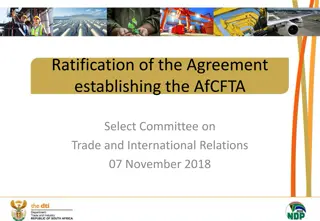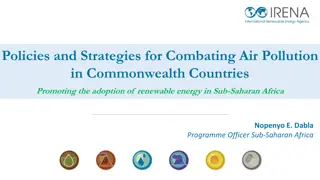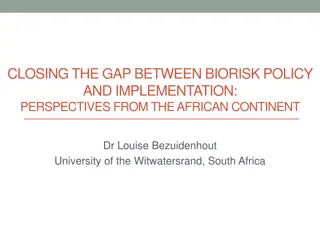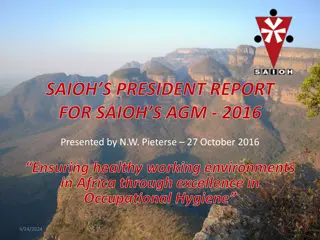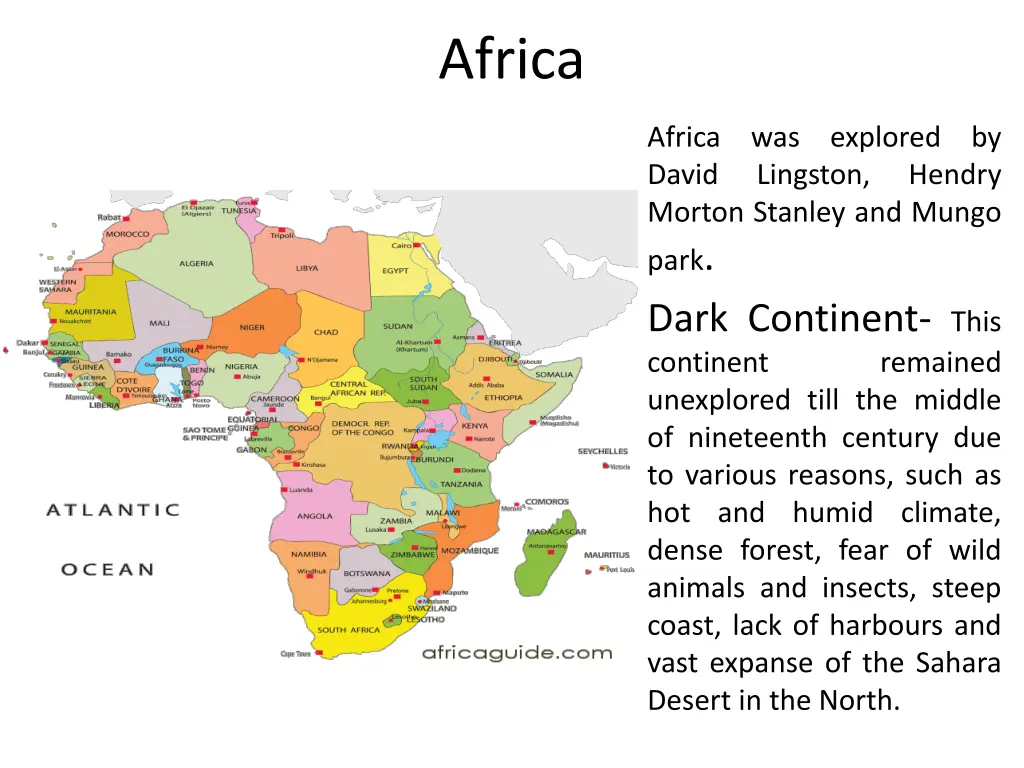
Exploring Africa: Landscapes, Climate, and Wildlife
Discover the unexplored beauty of Africa, from its diverse landscapes like plateaus and deserts to unique climates such as equatorial and tropical. Dive into the rich natural vegetation and wildlife that thrive in this continent. Learn about its political divisions, size, and geographical features like mountains and rivers that make Africa the second largest continent in the world.
Uploaded on | 0 Views
Download Presentation

Please find below an Image/Link to download the presentation.
The content on the website is provided AS IS for your information and personal use only. It may not be sold, licensed, or shared on other websites without obtaining consent from the author. If you encounter any issues during the download, it is possible that the publisher has removed the file from their server.
You are allowed to download the files provided on this website for personal or commercial use, subject to the condition that they are used lawfully. All files are the property of their respective owners.
The content on the website is provided AS IS for your information and personal use only. It may not be sold, licensed, or shared on other websites without obtaining consent from the author.
E N D
Presentation Transcript
Africa Africa David Morton Stanley and Mungo park. Dark Continent- This continent unexplored till the middle of nineteenth century due to various reasons, such as hot and humid climate, dense forest, fear of wild animals and insects, steep coast, lack of harbours and vast expanse of the Sahara Desert in the North. was Lingston, explored by Hendry remained
Location Three parallel of latitudes, the prime meridian also passes through his continent. Africa is surrounded by water on three sides. Towards the North- west Africa is separated From Europe by the Strait of Gibraltar. Towards North-East it is separated form Asia by the Strait of Babel- Mandeb. Construction of Suez canal, cuts through this isthmus and joins the Mediterranean sea with the red sea.
Size: It is the second largest continent of the world. Political Division : There are 54 independent countries in Africa. Physical Features: It is a combination of various types of landforms such as mountains, plateaus, plains rifts valleys, desert etc. a) Atlas Mountains lie in the north- western region of Africa. b) The Eastern part of the continent comprises of volcanic mountains such as Mount Kilimanjaro and Mount Kenya. c) The Darkensberg Mountains lie near the south eastern coast forming steep edges just like plateaus.
Plateaus- South Africa, Eastern African, Ahaggar Plains- Congo, Zaire Rift Valleys- Great rift valley Desert- Sahara, Kalahari and Nambi Rivers- Nile (longest river), orange, limpopo, zamberi Drainage- The equatorial region receives vey high rainfall, thus most of the rivers originates from the plateaus, they drop down from steep edges and become unsuitable for navigation.
Equatorial Climate Climate - Hot and wet climate, heavy rainfall throughout the year. It occurs in the afternoon and is known as the 4 o clock rain. Natural Vegetation- Trees are tall with broad leaves, creepers, thick undergrowth ebony, rosewood and mahogany Wildlife- Monkey, apes, rhinoceros and crocodile Tropical Climate Climate- Extremely hot summer with cool winter, scanty rainfall. A significance difference is observed between day and night temperatures. Natural Vegetation- Vegetation is sparse and includes shrubs and thorny bushes- Cactus, acacia, date palms Wildlife- Camels, reptiles like lizards, scorpions
Savanna Climate Climate-Hot summers mild winters. Rainfall is less than equatorial climate and it generally occurs in summer. Natural vegetation- Vast grasslands are called savanna small scattered throughout the region known as parkland. Vegetation and baobab tree. Wildlife- Deer, giraffe, zebras, buffaloes. Lions, elephants cheetahs and leopards. Mediterranean climate Climate- It has warm and dry summers and cool winters. It gets rainfall in winters. Natural Vegetation- SHORT EVERGREEN TREES. Trees are characterized by long roots. Wildlife-Domestic animals such as cattle and sheep are common. Highland Climate Climate- The temperature is generally low throughout the year. Scanty rainfall occurs during summer. Natural Vegetation- Type of vegetation changes with the altitude. Variety of grasses and confers. Eg- pine, fir, etc Wildlife- Deer. Zebras and variety of birds are seen here.
Temperate climate Climate- It has hot summers and cool winters . scanty rainfall occurs both during summer and winter. Natural Vegetation- grasslands known as veldts are found here. Shorter and softer grass of the veldts provide excellent pastoral land and supports livestock. Wildlife- cattle, sheep, donkey, cheetahs lions etc. Monsoon Climate Climate- It has hot summer and cool and dry winters. Winds blowing from Indian ocean causes rain during summer season. Natural Vegetation- Tropical deciduous trees grow in this type of climate. Wildlife- Monkey, elephants and deer are commonly seen here. China climate Climate-It has hot summers despite heavy rainfalls. Winters are cool. Natural vegetation- Deciduous trees grow here. Wildlife-Deer, zebras and monkeys and variety of birds are seen here.






